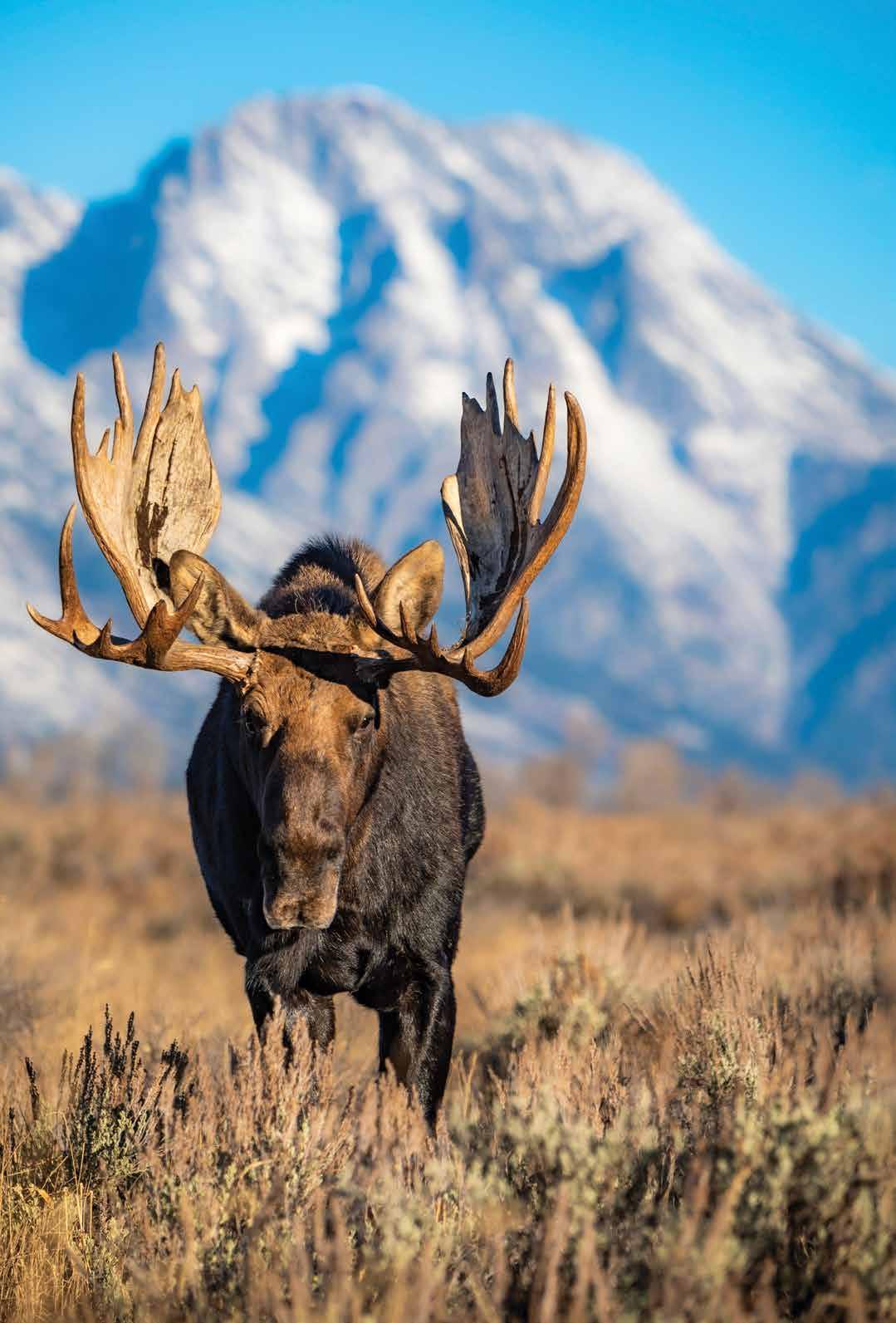




By Reis Ladd For Lone Star outdoor newS
Summer days along the Texas coast are known for the ever-present 15-20 mph southeast winds. Sprinkled throughout the gusty normalcy, though, there are days of an almost eerie stillness. Days where the surface of the water looks more like glass and the horizon line between the bay and the sky is difficult to distinguish. Those are the days coastal fly-fishermen relish.
Bryce Long, of Ricardo, and friend Cade Felps found themselves poling through the shallows of Baffin Bay on one of these days in early August.
“It was a glass morning with nervous water everywhere,” Long said. “In between spots, we burned through some nervous water and out from under the boat bull reds took off in all directions.”
Long shut down the motor and made a loop back toward the fish.
“It was hard to believe, there were at least 100 bull reds anywhere from 40 to 50 inches, and they were feeding on giant horse mullet,” Long said.
The pair presented nearly every fly they had, but as frenzied as the feed was, the reds weren’t responding.
“We tried all sorts of flies but don’t think anything was big enough,” Long said. “I finally found a 6- to 7-inch shrimp in my
turn to page 11
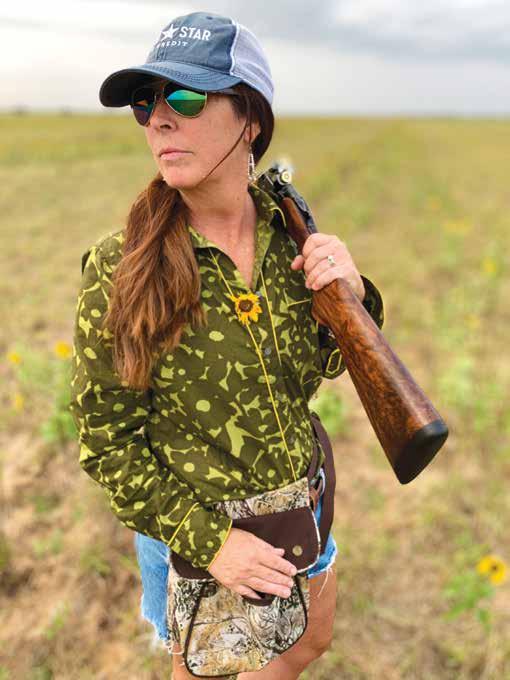
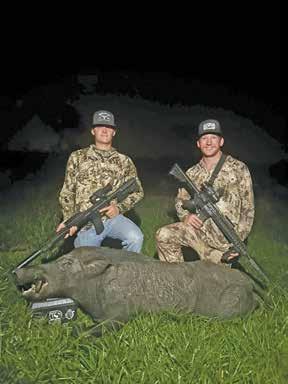
By Meghan Olivia Sharber For Lone Star outdoor newS
One unusual question is circulating among both female and male hunters as dove season approaches. What are you wearing on opening day?
Outdoorswoman Cami Rolf just snagged her opening day attire and is set from head to toe. Rolf believes it is not only important to blend in to have a successful hunt, but to also be comfortable and stylish.
“I love to hunt, but I like to always have a sense of fashion while doing it,” she said. “This year, I’ve planned to wear my new Duck Camp shorts, Chippewa snake boots, and an olive green Lululemon tank top paired with an old school camo print trucker hat.”
Rolf said she has been involved in the outdoors for as long as she can remember. No matter the hunt, Rolf said it is her passion, especially when she is doing it with friends and family.
Fashion trends in the hunting industry continue to progress each day and, according to outdoorsman Dean Meyer, it is certainly on the rise.
“I have been dove hunting since I was 5 or 6 years old,” Meyer said. “Everyone has their own way of enjoying the outdoors, but we can all agree on the positive impact it has.”
Meyer attributed the role of fashion in the hunting industry to it becoming more business related. Many businesses host dove hunts and, while for the guys it might not be about the look per se, since hunts are often a business and social event, he said you need to look presentable.
“On opening day, I have two options— my olive-green Skinny Water Culture long sleeve or Orvis camo,” Meyer said. “With the Texas heat, you can’t beat the lightweight material of Skinny Water Culture and Orvis has a great camo for dove
By Nate Skinner For Lone Star outdoor newS
Rowdy Kunz recently went out to his family’s ranch near Nada with his girlfriend, Katherine Ressler, and his buddy, Garrett Matura, to hunt with thermal optics. Ressler sent a drone with thermal imaging into the air as soon as they entered the property, and it wasn’t long before she spotted what looked like a pretty
large boar feeding in a field. Kunz and Matura confirmed the animal was indeed a large hog, and they made a move to try to get into position to get a shot at the pig that had been spotted across the property with the drone. Ressler kept the drone hovering about 400 feet above the field so that she could keep an eye on the boar’s movements as they all three, stealthily approached the edge of the field on foot.
In Texas, a special exemption approved in November, 2022, allows hunters to pursue feral hogs with the aid of drones, a practice which is not legal for other game.
“Using the drone really helped us figure out how to stalk in close enough for a shot,” Kunz said. “Katherine walked with us while piloting the drone and keeping us aware of the hog’s movements in the harvested cornfield where he was feeding.”
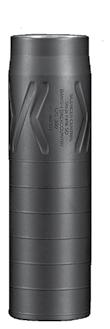



WHATEVER YOUR ADVENTURE IS, WE'VE GOT YOU COVERED.





By Craig Nyhus Lone Star outdoor newS
A recent study looked at the impact of summer drought on stress levels and reproduction of female white-tailed deer in South Texas.
Joseph Hediger, along with other Caesar Kleberg Wildlife Research Institute and East Foundation researchers, conducted the research during the
years 2015, 2016 and 2021 on four East Foundation ranches in South Texas. East Foundation lands are working cattle ranches, native wildlife are not hunted, and the predator population is unexploited. Vegetation characteristics and rainfall patterns varied among and within sites. Deer capture and sample collection A total of 124 repro-
ductively mature female white-tailed deer were captured via aerial netgunning during October and November of 2015, 2016 and 2021. Whitetailed deer develop fat reserves prior to the breeding season and then utilize currently available forage during late gestation and lactation to maintain their energetic requirements. In years with reduced rainfall and
poor environmental conditions, female deer may finance late gestation and lactation solely on body reserves.
Results
The paper concluded that reduced summer rainfall imparted longterm effects on female GC (glucocorticoid) levels, often referred to as stress hormones, but the effect of past environmental conditions depended on
By Nate Skinner
For Lone Star outdoor newS
Dove and teal seasons are on hunters’ minds, and biologists and outfitters expect plenty of action.
According to the TPWD Webless Migratory Game Bird Program Leader, Owen Fitzsimmons, dove hunters are in for an exciting and productive season this year.
“Statewide, mourning dove are on par with the good old days of 2014-2017, which were some of the best years in terms of mourning dove abundance in the last couple of decades,” Fitzsimmons said.
Since 2008, estimated statewide mourning dove populations have ranged from a low of 19.8 million birds in 2022 to a high of 37.5 million birds in 2016, according to TPWD data. TPWD spring dove surveys estimate the 2024 statewide population of mourning dove to be at about 34.2 million birds. This is the third highest estimate on record, and a 21-percent increase from 2023 and 24 percent above the long-term average.
“It’s important to recognize that these statewide population estimates refer to the estimated number of breeding adult birds,” Fitzsimmons said. “They don’t take into account the young, hatch-year birds that dove hunters can also expect to encounter during September. A high number of breeding adults, like we are seeing this year, usually means that there will be a lot of young birds around as well at the start of the season. So, hunters can expect to see a lot of
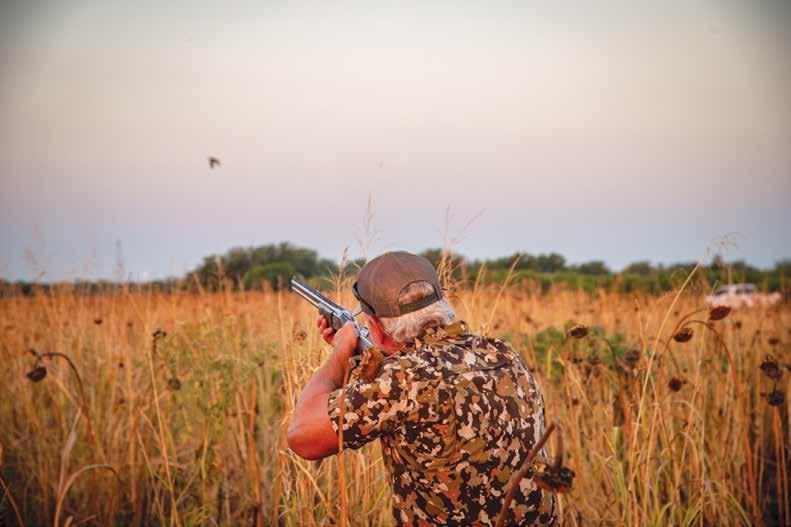
By Miguel Morales
For Lone Star outdoor newS
Clinto Brown, 58, of Brackettville, got the call at 7:30 a.m. from his long-time friend, Randy Methvin, of Uvalde. A rancher on the dry Frio River in Concan had game camera pictures at 4:15 a.m. of a mountain lion. The rancher contacted Methvin to let him know and asked him to contact Brown.
Brown has been after this cat a couple of times in the past two years. It had been seen on camera, and several of the ranchers in the area have found multiple cat kills of deer. He had always been a day or two late to the citing, but this time he loaded up the dog box with some hope.
“You gonna shoot that cat with your dads 60?” Brown asked. Methvin, 70,
looked puzzled. “Yeah the 60. 30+30 equals 60.” Brown hit the road and made it to the ranch at around 9:30 a.m. As Methvin arrived, Brown had collared his dogs, synced the collars and turned them loose. The two men sat at the truck, watched and listened intently to the art unfolding upon them.
The dogs trailed south, puzzling the two men since the game camera photos showed the cat heading north.
“If there’s anything I’ve learned in the past years, it’s to trust your dogs and let them work,” Brown said.
They trailed a riverbed south, then got up on a hill and headed north to the original way the lion went. The dogs trailed until the creek bed ended at the river.
After about three hours, the dogs started showing back up at the truck around noon, and it was pushing 100 degrees. As time went on, hopes were winding down, but two of his 10 dogs stayed on the trail.
The dogs, Greedy and Burrito, were far enough away that Brown could not hear any barking, but moments later the GPS was showing they had something treed. He loaded up his returned dogs and headed to the mark.
“We were able to drive up within 100 yards of the mark, but it was so dang thick,” Brown said. “When we pulled up, Greedy let out her treed bark and got all the other dogs riled up. That’s all it took for them to find their energy again.”
When he let the dogs out, they all darted for Greedy.


By David J Sams
Star outdoor newS
It was a busy Saturday (Aug. 17) in San Antonio for hunters. The Texas Trophy Hunters Association extravaganza was taking place at Freeman Coliseum and the Texas Deer Association annual convention was happening at the JW Marriott Hill Country Resort & Spa.
At Freeman Coliseum, hunters filled the TTHA exhibit hall, and people were buying.
Eric Gonzales, of A&E Outfitters, said the crowd seemed larger than in past years. He had sold all of his All Seasons Feeders as two men left the booth, each carrying one of the new stainless steel bumper feeders.
At the Texas Dove Hunters Association booth, people were lined up to register for the Banded Bird Challenge, and all were discussing the upcoming dove season opener.
Fishing guide and hunting dog trainer Nathan Beabout said the show was going well. His booth drew a big crowd, possibly thanks to the beautiful Labrador retriever puppies he had remaining for sale.
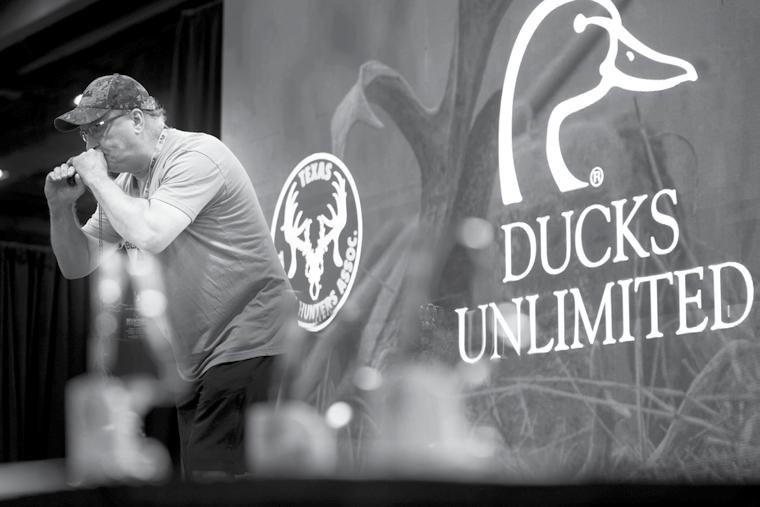
At the Texas Trophy Hunters Association Extravaganza in Fort Worth, the sounds of duck calls permeated the room.
The Texas Ducks Unlimited Duck Calling Contest, including the sanctioned Texas State Duck Calling Championship, took place at the show.
“It was kind of an impromptu venue that came up at the last minute,” said DU’s Director of Fundraising and Volunteer Relations Mike Wilson. “It turned out it was the perfect place to have a calling contest. We look forward to returning to Fort Worth next year.”
As at any duck calling contest, some of the vendors grumbled while listening to the contestants warm up for the contest. But once the actual contest began at the seminar stage, no complaints were heard.



























mourning dove this year.”
White-winged dove population estimates have also increased from last year’s record high numbers.
“Whitewing populations are yet again at an all-time high,” Fitzsimmons said. “The 2024 statewide population is estimated at 12.8 million birds. This represents a 4-percent increase from 2023, and is also 27 percent above the long-term average estimated statewide population. Whitewing populations have come a long way from being estimated at only 6.7 million birds statewide back in 2008.”
According to Fitzsimmons, Texas received more rain from January-July of this year than it normally does in most 12 month periods. There are some areas in the Hill County and Trans-Pecos regions of the state that have remained dry, but overall, conditions for dove have been excellent in most areas.
“As long as we can avoid any significant or severe tropical activity, I think hunters can expect to experience a memorable dove season in most portions of the state,” Fitzsimmons said. “The birds could be somewhat scattered, with all of the water and food sources available to them across the landscape. Recent summer rains should result in some excellent, late-summer forb growth that will be seeding out just in time for some prime late season opportunities.”
Blue-winged teal numbers are expected to be above average as well. TPWD’s Waterfowl Program leader, Kevin Kraai, said waterfowl hunters can expect to enjoy an above average early teal season across most of the state, due to the wet conditions this year.
“Habitat conditions across much of Texas are currently above average to excellent,” Kraai said. “Near-record precipitation in East Texas has filled reservoirs to capacity, providing tens of thousands of acres of flooded shorelines rich in food for teal. Additionally, summer tropical weather along the Gulf Coast has created an abundance of fresh, shallow water, significantly improving conditions compared to last year.”
Above-average summer rainfall across much of their breeding grounds is expected to have positively impacted duckling production and survival for teal.
“Despite the decade-long decline in the estimated breeding population, production of blue-winged teal is expected to be strong this year,” Kraai said. “We’re keeping a close eye on the continual decline in the estimated breeding population of teal, which is due to ongoing drought conditions in much of their breeding grounds. Time will tell if this decline will have impacts on regulations for future seasons.”
Kraai said reports indicate that more and more teal have been arriving in the state each day. The early teal season runs Sept. 14-29.






Kunz said they were walking along a ranch road next to a fence line at the perimeter of the field.
“All of a sudden, Katherine told us the boar was starting to move in our direction and looked as if he was going to exit the field,” Kunz said. “We steadied our .223 AR platform rifles on tripods and began to scan out in front of us with the thermal optics mounted on the rifles. Sure enough, we were able to see the large pig cross through the fence at the edge of the field, and onto the ranch road that we were walking on out in front of us.”
Kunz said they knew the pig wasn’t farther than about 50 or so yards, and that is was pretty big in size.
“Our adrenaline was pumping,” he said. “The hog was walking across the road broadside, and I began to count down — 3, 2, 1. We both shot at the same time, and the pig fell instantly.”
Kunz said the hog is the largest one he has harvested, weighing 273 pounds.
“You hear folks say all the time that they saw or harvested a wild hog weighing over 300 pounds,” Kunz explained. “For some reason, the 300-pound mark is one that a lot of people like to use for reference or comparison, but the truth is, that a true 300-pound hog is a downright giant. That’s what prompted me to get a scale and start weighing the hogs I harvest.”
The group didn’t really realize how heavy the hog was until they started moving him around.
“Once we tried to reposition him to a take a picture, we knew he was pretty heavy,” Kunz said.

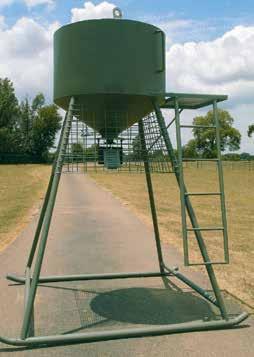
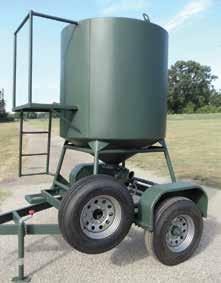



















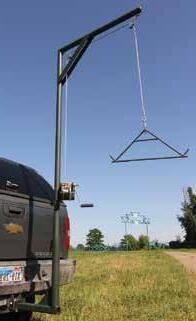

By Nate Skinner For Lone Star outdoor newS
Capt. Trent Adams had a hunch. He felt the large speckled trout were feeding aggressively at night, when water and air temperatures were at their coolest. He was right — proven when he landed a 30-inch fish.
Adams, who operates Purple House Charters, had been having success during his morning trips, but felt there was an opportunity to catch some bigger fish that were likely lethargic during the daytime hours due
By Nate Skinner
For Lone Star outdoor newS
Stripers and hybrids are providing anglers with plenty of action as they hold tight to their late summer patterns. They are schooling along the surface and down deep. Stripers have been more willing to strike artificials, while most hybrid catches have been coming on live bait.
On Lake Texoma, Capt. Stephen Andre said the stripers are feeding along the surface during the early morning hours before retreating to deeper water as the sun rises overhead. The schooling action at dawn has been taking place in shallow stretches with 5-10 feet of water. Water depths between 40-60 feet adjacent to river ledges have been holding concentrations of fish as temperatures heat up.
“The stripers are schooling along the surface and chasing large gizzard shad up shallow at sunrise,” Andre said. “They’ll eat just about anything when they’re feeding along the surface, and my anglers have been chunking full-sized topwaters at them.”
Once the schooling action dies off, slabs have been best for targeting the stripers in deeper water. Andre said the fish have been suspending throughout
the water column in schools.
“Most of the fish that we are catching are in the 7- to 8-pound range,” he said.
“The largest fish that we have been catch ing have been coming out of the schools feeding along the surface up shallow during the early morning hours.”
Andre said the schools of stripers have been on the move, and he’s been having to cover plenty of water to keep up with them.
On Richland Chambers Reservoir, guide Joe Moore said the hybrid bite has been pretty steady for those fishing with live bait. Limits have been fairly consis tent in about 20 feet of water.
“Gizzard and threadfin shad are pro ducing plenty of action,” Moore said.
“We are catching hybrids up to 10 pounds, with a lot of fish in the 2- to 4-pound range.”
Moore said the hybrids have been roaming the lake in decent-sized schools.
“Once you find them, you can gener ally catch quite a few in a hurry,” he said.
On Lake Whitney, the striper fishing has been tough of late. Guide Blake Stritz said the lake is chock full of baitfish right now, and the fish do not have to exert a lot of effort to find a meal.
“The stripers that are being caught on
Please turn to page 20

to the scorching, late summer heat.
On a day where he had a break between trips with clients, Adams and some buddies set out to test his theory. They started fishing a little before sunset and spent an entire night wade-fishing flats in West Galveston Bay. At about 1:30 in the morning, the big bite came.
“We were wading a large sand flat in about waist-deep water, about 50 yards from the edge of a dropoff when the fish struck the soft plastic I was throwing,” Adams said. “At first I thought I had hooked a redfish. It
wasn’t the typical, head-shaking fight you would expect from a trout, and it wasn’t until I turned my headlamp on as she got closer and I saw her in the light shining on the surface that I realized I was hooked up with a big speck.”
Adams was able to bring the fish to hand, and he knew immediately that it had the potential to be the largest trout he had caught in the Galveston Bay complex.
“The fish was actually pretty skinny for her length, and looked as if she had just recently spawned out,” he

By Tony Vindell
For Lone Star outdoor newS
The latest Ladies Kingfish Tournament was a battle for the heaviest fish after which the tourney is named, the strong and fighting kingfish.
Up to six entries were logged on the scoreboard, but each outweighed the first up to one minute before the official weigh-in came to an end at 7 p.m. Aug. 10 at the Port Isabel Marina.
The tournament, which celebrated its 43rd year, attracted 150 women who competed in bay
and offshore waters during the day-long tournament.
In the bay fishing division, Laney Davis, of Harlingen, took the Grand Champion spot.
She caught a Texas Grand Slam, made up of a trout, a redfish and a flounder. The three fish weighed a combined 12.95 pounds.
“I am super excited. It was a tough day but it turned out great,” she said. “I have been fishing this tournament for about 25 years and this is the first time I have won this (the top prize).”
Davis said the boat also took the Calcutta first prize, which
means some cash was taken home, as well. She said fishing was tough as it was hot with barely any wind.
Davis caught her trout at 9:30 a.m., the flounder at 11 a.m., and the redfish at 2:30 p.m.
In the offshore division, Debbie McNair, of San Antonio, was the big winner.
She caught all four fish in this category — a bluefin tuna, dorado, kingfish and a bonito. The four fish weighed a total of 26.2 pounds.
“I have fished LKT for more than 25 years,” she said. “But this
By Miguel Morales
For Lone Star outdoor newS
Three young anglers had a big time chasing largemouth bass from a small boat on the Nueces River.
On August 10, Diego Medina, 21, and Julian Ruiz, 24, of Sabi nal, and 20-year-old Tyler Lee, of Thrall, arrived in the early morn ing to view crystal-clear water. They launched their three-seat Pelican Bass Raider equipped with raised seats, a trolling mo tor, sonar and some paddles.
“It’s gone back down a bit,” Ruiz said of the river.
A few weeks prior, the water rose in the Nueces and the Frio rivers from some much needed rain. Medina said the water had risen a couple of feet and the current had greatly increased. The weekend of their trip, the current had receded and the depth was almost back to prior levels. The deeper pockets of wa ter weren’t completely stagnant, but not far off.
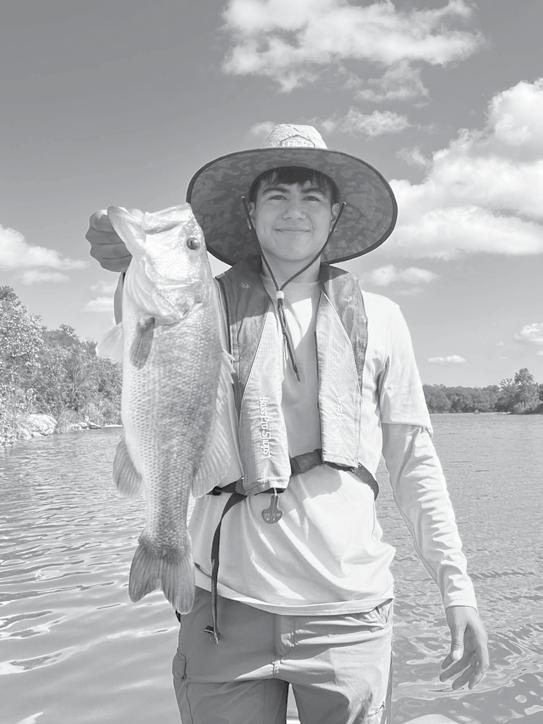
Once launched, it didn’t take the trio long to get on fish. After about 10 minutes, Medina hooked into the first and set the tone for the day. Next, Ruiz and Lee got on the board. But after the initial excitement, the boys were humbled.
“It was off and on every 30-45 minutes, then we’d get hit with three or four bites back-toback,” Lee said. “It seemed like they were hanging out in schools on the under cuts of the bank.”
The group had their best luck with fast retrieved square-bills and bouncing drop shots along the bank.
“Once we got on them, we would double and triple up, but we had to find them first,” Medina said.
By Tony Vindell
For Lone Star outdoor newS
A 647-pound blue marlin caught during the 84th annual Texas International Fishing Tournament could not be entered as the largest billfish brought in during the two-day competition.
The fish made it to the docks two hours after the weigh-in closed, so it was disqualified per tournament rules.
The fish was caught by Riley Rhodes, of Port Aransas. He fished off the Walk West vessel and it took him more than an hour to get the fish on board.
However, by the time the boat arrived at the dock it was somewhere around 10 p.m. on Friday, Aug 2, or two hours past the tournament 8 p.m. deadline.
Tournament officials and others stayed at the docks past midnight as the fish was hung, weighed and showed to the few people who stayed late. But for everybody on the boat, it was a joyful moment to display the fish for the cameras.
That rare occurrence was the talk of the tournament as people wondered what might have happened, as the fish would likely have earned tens of thousands of dollars.
Capt. Rowley Morrison and Rhodes’ son said they were happy with the outcome even though they realized the end-result wasn’t what they had expected.
Asked whether they were disappointed, they simply said they do a lot of marlin fishing and that they were “very happy for hooking and landing such a fish.”
At the event with 1,080 competitors, a number of billfish were weighed in, including the winning 396-pound blue marlin, landed by Miya Whittington, of South Padre Island.
“It’s exciting to bring in such a catch,” she said after the cameras snapped shot after shot of her and her fish. “This was my second of two billfish I caught in the tournament.”
Another Port Aransas team, called Coyote,

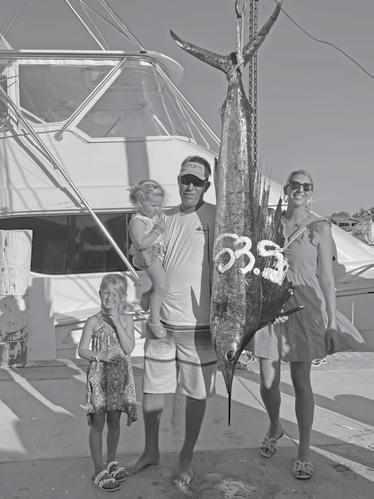







ALAN HENRY: Water clear; 84 degrees; 1.41’ low. Crappie are good on minnows.
AMISTAD: Water lightly stained; 89 degrees; 68.24’ low. Largemouth bass are fair on drop shots, creature baits and Texas rigs. White bass and stripers are good on crankbaits, Alabama rigs, spoons and blades.
ARLINGTON: Water stained; 88 degrees; 2.07’ low. Largemouth bass are fair on soft plastics. Crappie are fair on jigs and minnows. Catfish are good on cut bait under a bobber.
ARROWHEAD: Water lightly stained; 86 degrees; 4.91’ low. Crappie are fair on jigs and minnows. Catfish are fair on fresh cut shad.
ATHENS: Water stained; 87 degrees; 0.34’ high. Largemouth bass are fair on jigs and shaky-head worms. Crappie are slow.
AUSTIN: Water stained; 85 degrees; 0.74’ low. Largemouth bass are fair on jigs, soft plastics and top-waters.
B A STEINHAGEN: Water stained; 85 degrees; 1.34’ low. Largemouth bass are fair on soft plastics. Crappie are fair on jigs. Catfish are fair on juglines.
BASTROP: Water stained; 90 degrees. Largemouth bass are good on swimbaits and top-waters.
BELTON: Water stained; 87 degrees; 0.05’ high. White bass are fair on pet spoons and slabs. Catfish are good on live perch and shad.
BENBROOK: Water stained; 80 degrees; 1.78’ low. Largemouth bass are good on soft plastics. Crappie are good on live minnows. Hybrids are good on shad and minnows. Catfish are good on chicken liver, worms and live bluegill.
BOB SANDLIN: Water lightly stained; 93 degrees; 0.22’ high. Largemouth bass are good on crankbaits, drop shots and Texas rigs. Crappie are good on minnows. White bass are good on spinner baits. Catfish are good on cut bait and stink bait.
BOIS D’ARC: Water stained; 85 degrees; 0.85’ low. Largemouth bass are fair on lipless crankbaits, shaky heads, Texas rigs and creature baits.
BRAUNIG: Water stained, 95 degrees. Largemouth bass are slow. Redfish are fair on live bait and spoons. Catfish are good on cut bait and cheese bait.
BRIDGEPORT: Water stained; 87 degrees; 10.41’ low. Largemouth bass are
good on top-waters, Texasrigged worms and crankbaits. Crappie are good on minnows and jigs. White bass and hybrids are fair on slabs. Catfish are good on prepared baits and cut shad.
BROWNWOOD: Water stained; 86 degrees; 3.12’ low. Largemouth bass are fair on soft plastics and shaky heads. Crappie are slow. White bass are fair on jigs and crankbaits. Catfish are good on prepared bait.
BUCHANAN: Water stained; 86 degrees; 10.87’ low. Largemouth bass are fair on soft plastics and top-waters. White bass, hybrids, and stripers are fair on top-waters and live bait. Crappie are good on minnows. Catfish are good on shad and punch bait.
CADDO: Water stained; 80 degrees; 0.50’ high. Largemouth bass are good on flukes, buzz baits, lipless crankbaits and spinner baits.
CALAVERAS: Water lightly stained; 97 degrees. Largemouth bass are slow. Redfish are fair on live bait, gold spoons and swimbaits. Catfish are good on cut bait and cheese bait.
CANYON: Water stained; 85 degrees; 23.15’ low. Largemouth bass are fair on drop-shot rigs.
CEDAR CREEK: Water lightly stained; 87 degrees; 0.47’ low. Hybrids and white bass are good on spinners and slabs. Crappie are fair on jigs and minnows. Catfish are good on cut shad.
CHOKE CANYON: Water stained; 86 degrees; 30.04’ low. Largemouth bass are fair on soft plastic worms and flukes. Crappie are fair on minnows. White bass are fair on slabs. Catfish are fair on cut bait and stink bait.
CONROE: Water stained; 90 degrees; 0.02’ high. Largemouth bass are good soft plastics and crankbaits. Crappie are fair on minnows. Hybrids and white bass are fair on live shad, large minnows, and jigging spoons. Catfish are good on cut bait and punch bait.
slabs with teaser flies. Crappie are fair on jigs. Catfish are good on punch bait.
FALCON: Water stained; 85 degrees; 45.66’ low. Largemouth bass are good on plastic worms and crankbaits. Crappie are slow. Catfish are good on shrimp.
FAYETTE: Water stained; 95 degrees. Largemouth bass are good on crankbaits and underspins. Bluegill are good on nightcrawlers.
FORK: Water stained; 81 degrees; 0.42’ low. Largemouth bass are fair on swimbaits, frogs, chatter baits and Carolina rigs. Crappie are good on minnows. Catfish are good on prepared bait.
FT PHANTOM HILL: Water stained; 85 degrees; 7.47’ low. Largemouth bass are good on top-waters. Hybrid stripers are good on live shad. White bass are fair on crankbaits and live shad.
GRANBURY: Water stained; 87 degrees; 0.27’ low. Largemouth bass are fair on crankbaits and soft plastics. Striped bass are fair on live bait. White bass are good on slabs. Catfish are fair on cut and prepared baits.
GRANGER: Water lightly stained; 85 degrees; 1.60’ high. Largemouth bass are good on plastic worms. Crappie are good on minnows. White bass are good on slab spoons. Catfish are good on shad or cut bait.
GRAPEVINE: Water stained; 85 degrees; 2.23’ high. White bass are good on slabs and jigs.
HUBBARD CREEK: Water stained; 85 degrees; 13.33’ low. Largemouth bass are slow. White bass are fair on slabs. Catfish are fair on live bait or cut carp.
JOE POOL: Water lightly stained; 88 degrees; 0.56’ high. Largemouth bass are fair on soft plastics. Crappie are fair on jigs and minnows. Catfish are fair on shad and cut bait.
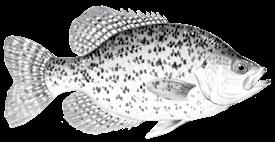
COOPER: Water stained; 83 degrees: 2.00’ low. Hybrids and sand bass are good on spoons or slabs. Crappie are good on jigs and minnows. Catfish are good on cut bait.
EAGLE MOUNTAIN: Water stained; 83 degrees; 2.76’ low. White bass are good on
LAKE O’ THE PINES: Water stained; 90 degrees; 0.21’ high. Largemouth bass are good on Texas-rigged worms, jigs and wacky rigs.
LAVON: Water lightly stained; 80 degrees; 0.03’ feet high. Largemouth bass are fair on spinner baits, crankbaits, Texas rigs and Carolina rigs. White bass are fair on slabs. Crappie are good on jigs or minnows.
LBJ: Water stained; 86 degrees; 0.26’ low. Largemouth bass are fair on crankbaits, jigs and soft plastics. Crappie are good on minnows. Catfish are good on punch bait.
LEWISVILLE: Water stained; 86 degrees; 0.38’ high. Largemouth bass are slow. White bass are fair on slabs, jigs and live bait. Hybrid stripers are fair on slabs and live bait. Crappie are fair on minnows and jigs. Catfish are fair on cut shad and punch bait.
LIMESTONE: Water lightly stained; 90 degrees; 0.60’ low. Largemouth bass are fair on soft plastics. Crappie are good on minnows and jigs. White bass are good on spoons. Catfish are fair on cut bait.
LIVINGSTON: Water lightly stained; 88 degrees; 0.10’ high. White bass are good on jigs and slabs.
MARTIN CREEK: Water stained; 94 degrees; 0.30’ low. Largemouth bass are good on worms, underspins and crankbaits. Crappie are good on jigs and minnows. Catfish are good on live bait and nightcrawlers.
O H IVIE: Water lightly stained; 86 degrees; 31.40’ low. Largemouth bass are good on swimbaits and top-waters. White bass are fair on lipless crankbaits and top-waters. Crappie are good on minnows and jigs.
OAK CREEK: Water lightly stained; 80 degrees; 17.67’ low. Largemouth bass are fair on large plastic worms and swimbaits. Crappie are fair on minnows and jigs.
PALESTINE: Water lightly stained; 91 degrees; 0.05’ high. Hybrid stripers are fair on pet spoons. Crappie are fair on minnows.
POSSUM KINGDOM: Water stained; 86 degrees; 0.56’ low. Largemouth bass are fair on crankbaits, Carolina rigs and drop shots. Stripers are fair on live bait. White bass are slow. Catfish are fair on cut shad.
PROCTOR: Water stained; 85 degrees; 3.14’ low. Catfish are fair on punch bait and cut bait.

MEREDITH: Water stained; 81 degrees; 47.34’ low. Largemouth bass are good on minnows and artificials. White bass are good on slabs. Walleye are good on minnows, grubs and artificials. Catfish are fair on crawlers, minnows, chicken liver and frozen shad.
NACOGDOCHES: Water stained; 90 degrees; 0.33’ low. Largemouth bass are good on swimbaits, Carolina rigs and crankbaits. Crappie are good on jigs. Catfish are slow.
NACONICHE: Water stained; 89 degrees; 0.50’ high. Largemouth bass are fair on weightless flukes, jerkbaits and Texas rigs. Crappie are good on minnows and jigs. Catfish are slow.
NASWORTHY: Water lightly stained; 88 degrees. 0.38’ low. Largemouth bass are good on chatter baits, spinner baits and soft plastics. Crappie are good on jigs. Catfish are fair on cut bait and stink bait.
NAVARRO MILLS: Water lightly stained; 80 degrees; 3.03’ high. Largemouth bass are fair on crawfish jigs. White bass are good on slabs. Crappie are fair on minnows. Catfish are good on punch bait.
RAVEN: Water stained; 83 degrees. Largemouth bass are fair on soft plastics. Crappie are fair on minnows and artificial grubs. Catfish are fair on worms.
RAY HUBBARD: Water stained; 85 degrees; 0.31’ low. White bass are fair on slabs. Crappie are fair on minnows. Catfish are fair on cut shad.
RAY ROBERTS: Water lightly stained; 83 degrees; 0.75’ high. White bass are fair on top-waters and slabs. Crappie are fair on minnows and jigs. Catfish are good on punch bait.
RICHLAND CHAMBERS: Water stained; 88 degrees; 0.10’ high. White bass are slow. Hybrid stripers are fair on live bait. Catfish are good on shad and punch bait.
SAM RAYBURN: Water stained; 89 degrees; 5.35’ high. Largemouth bass are slow. Crappie are fair on jigs and minnows. White bass are fair on slabs. Catfish are good on cut bait.
SOMERVILLE: Water stained; 87 degrees; 2.49’ high. Crappie are fair on jigs and minnows. White bass are fair on spoons and live bait. Hybrids are good on cut bait. Catfish are fair on cut shad and punch bait.
n Saltwater reports Page 20
STILLHOUSE: Water stained; 88 degrees; 2.15’ high. Largemouth bass are fair on Texas-rigged soft plastics.
TAWAKONI: Water lightly stained; 86 degrees; 0.34’ low. Largemouth bass are fair on frogs and top-waters. Hybrid stripers and white bass are good on shad, swimbaits and slabs. Crappie are fair on minnows and jigs.
TEXANA: Water stained; 80 degrees; 0.03’ low. Catfish are fair on cut bait and punch bait.
TEXOMA: Water stained; 75 degrees; 0.90’ high. Largemouth bass are slow. Striped bass are fair on live shad, slabs and swimbaits. Crappie are slow. Catfish are good on punch bait and prepared baits.
TOLEDO BEND: Water lightly stained; 91 degrees; 1.63’ low. Largemouth bass are fair on top-waters, Texasand Carolina-rigged worms and crankbaits. Crappie are slow.
TRAVIS: Water lightly stained; 89 degrees; 39.11’ low. Largemouth bass are fair on swimbaits, jigs and Texasrigged worms.
WACO: Water stained; 80 degrees; 0.52’ high. Largemouth bass are slow. Crappie are good on minnows and jigs. Hybrids are fair on swimbaits and spoons. Catfish are good on cut bait and live shad.
WALTER E LONG: Water stained; 85 degrees. Largemouth bass are slow. Crappie are good on jigs.
WHITNEY: Water lightly stained; 84 degrees; 0.03’ high. Largemouth bass are slow. Striped bass are slow. Crappie are fair on jigs and minnows. White bass are slow. Catfish are fair on cut shad.
SPENCE: Water stained; 85 degrees. 49.82’ low. Largemouth bass are fair on soft plastics. White bass are good on top-waters and spoons. Catfish are good on cut bait.
WORTH: Water stained; 83 degrees; 2.44’ low. White bass are good on slabs. Crappie are fair on jigs. Catfish are good on punch bait.
—TPWD

Continued from page 9
caught a 53.50-pound sailfish, taking first place for that species.
The tournament was held under one of the best weather conditions anglers could ask for, resulting in plenty of fish brought in from both the bay and offshore divisions.
And Julie A. Coulter caught a 74-pound white marlin with the Deez Nautz team.
Some bay anglers said they caught plenty of redfish though many of them said they were not big or heavy enough to make it the finals.
Others, particularly those fishing offshore, caught plenty of fish species, including, kingfish, ling, mackerel, dorado and wahoo.
In the tarpon division, Isla Gonzalez, at age 11, decided to fish against the adults and won the title. Capt. Brian Barrera said the youngster went fourfor-15 on the tough fish.
Gonzalez wasn’t the only youngster to win in the adult divisions. Oliver Schwarz won the Bay Grand Champion title and Halle Bryant was the Offshore Grand Champion.
Melissa Mikulik, president of Texas’ largest saltwater fishing tournament, said everything went well.

“It has been a very successful tournament,” she said. “We had a lot of fish coming in.”
Continued from page 9
After a day filled with 1- to 2-pound bass, Medina hooked into a better fish.
“I was bouncing my drop shot off the bottom when I felt a solid hit,” he said. “I reeled in my slack and set the hook.”
After a short fight, Medina brought the fish to the surface and Ruiz netted it.
“We put it on a scale and were pleasantly surprised to see it weigh right at 4 pounds,” Medina said. “There are big fish in this river — we’ve seen several 7-8 pounders. You just have to be patient and put in the time to find them.”
After fishing into the afternoon the boys decided to start making their way back to the truck and end their trip on a good note. On the way back they caught another few fish in the spots they had previously found the bass in schools. By the end of the trip Medina, Ruiz and Lee had caught and released 22 bass.
“Catching is obviously fun, but it was about enjoying some quality time with your buddies before school takes over again,” said Lee, who began his junior year at Sul Ross State University.
Continued from page 1
tackle and got one to eat.”
Long fought the bull red on his 7-weight set up for 15 minutes before he was able to land the fish. Upon retrieval out of the water for a few photos, the fishermen noticed something protruding from the big red’s mouth. It was the silver forked tail of a mullet they estimated to be at least 15 inches long. The red was released, mullet meal still intact.
As the two continued to stalk the school of reds, they noticed another school of feeding fish approaching on an intersecting course. As the new feeding frenzy came in close enough for identification, Long and Felps could make out the hungry speckled trout.
“While we were following the reds a school of trout intersected and they were all intermingled and those trout were hungry,” Long said. “It didn’t matter what you threw, it was every cast.”
Long and Felps chased the school of reds a little while longer before hooking into another, but that fish had other plans and not only broke the line but also the rod, the same rod used to catch the previous bull red. Not having any other similar flies, the two followed the school and watched from afar, enjoying the show.
Long’s fish had been measured on the now broken rod, but Long and Felps estimated the bull red was between 48 and 52 inches.

A local fishing guide who witnessed a Mexican commercial fishing vessel operating on the Texas side of Falcon Lake called local game wardens. The wardens located and seized seven hoop nets. Hundreds of fingerling sized catfish and turtles were returned to the water. Additionally, Zapata County game wardens have seized several thousand feet of monofilament gill net and gar net that do not fit within state guidelines.
The Lamar University Police Department contacted Beaumont area game wardens. A small 4-5foot alligator became was located at the Spindletop Museum. A Jefferson County game warden was in the area and responded within minutes. He caught the small gator and relocated him to a better habitat in the marsh a few miles away.
The Laredo Police Department reported a sighting of a mountain lion in south Laredo. A man who saw the animal said he opened his garage door and saw the mountain lion resting. According
The Coast Guard medevaced a 15-year-old who lost consciousness approximately 51 miles south of Freeport. After receiving a Mayday call from the vessel, a helicopter crew was dispatched. Once at the scene, the crew hoisted the patient and transported him to the University of Texas Medical Branch in Galveston in stable condition.
to the Laredo Police Department, officials tried to sedate the animal. However, it tried to get away and due to the safety of the public, the animal was shot and later died. Officials said the animal became agitated and aggressive when sedation attempts were made, and the animal had to be euthanized.
The day before, an east Laredo neighborhood had also reported the sighting of a mountain lion. Footage from a resident showed a wild cat jumping over a gate and into someone’s backyard.
Two persons died after two boats crashed at Lake Tyler. The Tyler Police Department was contacted by Texas game wardens to assist with responding to the crash. The initial investigation found that a fishing boat with a man in it reportedly hit a flat-bottomed boat with two women and a man in it. One 38-year-old woman was unresponsive and was taken to a local hospital, where she later died. Another woman had non-lifethreatening injuries. A 38-year-old
man was in the flat-bottomed boat and was originally reported as missing but was later found dead. Game wardens are investigating the crash with the cooperation of the fishing boat driver. Smith County Emergency Services District #2 and Longview Fire Department Water Rescue also assisted in responding to the crash.
A new helicopter has been added to the Texas game wardens’ fleet of law enforcement aircraft. The


2023 Airbus H125 helicopter will allow the Aviation Unit to expand their statewide response capacity for natural disasters, search and rescue incidents, air patrols and more, according to TPWD. The aircraft is outfitted with the latest law enforcement technology and emergency response equipment, including a rescue hoist, thermal imager, searchlight, public address system, satellite communication, night vision and firefighting equipment. The new aircraft, which cost approximately $6.5 million, was made possible through legislative appropriation during the 87th Texas legislative session. Based out of Austin, helicopter crews consist of a game warden pilot and a tactical flight officer. Both helicopters in the fleet have the capacity to carry additional game wardens and personnel, including K9 teams, during remote search and rescue missions and natural disaster response.

Remember when a hunter was measured by how well he shot, and not how much he spent? When memories were measured in curly tails, not dollar bills? We do. And that is why we created the Spandau S2. A reliable, extremely well balanced waterfowl gun built around the Inertia operating system for unmatched performance at a price that shows that you still know the true measure of a hunter.











26
28
06:57 07:46 3:33a 6:07p
31 Sat 3:54 10:06 4:18 10:30 06:57 07:44 4:34a 6:43p
01 Sun 4:38 10:49 5:00 11:12 06:58 07:43 5:33a 7:15p
02 Mon 5:20 11:30 5:41 11:51 06:58 07:42 6:30a 7:44p
03 Tue 6:01 ----- 6:21 12:31 06:59 07:41 7:25a 8:10p
Aug




Solution on Page 26

ACROSS
1) Elk hunters’ org.
5) Dove weed
7) Shooting sport
9) One of the cats
11) The red tractor
13) Henderson County’s seat
15) Goose-hunting province
16) A goose group
18) Sinker type
19) Shotgun type
20) Trout species
21) Shot size used by dove hunters
22) Worm rigging style
25) Goos area to target bass
27) Group of horses
29) Windhoek’s country
31) Thermal optics brand
32) Group of skunks
33) Salmon species
35) Delta County’s seat
38) International hunting org.
39) DFW-area lake, Ray ____
41) Fishing line brand
43) Brewster County’s seat
44) Don’t forget to ____ the dove
45) Big Sam
DOWN
1) Favorite duck on the coast
2) Spinning-wing decoy brand
3) Take plenty on the dove hunt
4) Hunting boot brand
6) The big crappie
8) Bass boat brand
10) Huntsville’s county
11) Henrietta’s county
12) Fishing leader brand
14) An African antelope 17) Bowhunters’ favorite month
18) Turkey call type 20) Crankbait brand
23) Coastal bay
24) West Texas river
26) Shotshell brand
28) DeWitt County’s seat
29) East Texas river
30) Protrusion on the hook
34) A Great Lake
35) New Braunfels’ county
36) Rifle brand
37) A duck favorite
40) The crossbow arrow
42) Shotgun brand

marketing manager at Yamaha
Yamaha U.S. Marine Business Unit named Scott Higgins as division manager, outboard marketing.
Hodgdon joins RCBS
Reloading industry leader RCBS named Joel Hodgdon as the company’s new marketing director.
Archery coach sought
USA Archery is seeking a National Head Coach.
Duke hired by NPFL
The National Professional Fishing League hired longtime industry media professional Ken Duke to lead its media and communications efforts.
Growth recognition for Silencer Central
Silencer Central was recognized by Inc. Magazine as one of the fastest-growing private companies in America, ranking second among companies in South Dakota.
Sales group for Rambo Bikes
Rambo Bikes retained independent sales representation group MWS Associates.
Promotions at RMEF
The Rocky Mountain Elk Foundation promoted Jennifer Doherty to managing director of mission operations and Riza Lesser to the newly created position of managing director of brand and communications.
Jasa named sales director
Stan Outdoors named Dan Jasa as director of sales and marketing.
Rep group for Antler King
Antler King selected Outtech as its sales and marketing representatives.
at Leupold
Leupold & Stevens, Inc. promoted Kevin Graves, Cody Braden, and Josh Andrews, three members of its nationwide sales team, to regional sales managers.
Ring promoted at Iron Valley
Distributor Iron Valley Supply promoted Jacob Ring to director of product management.

2 lbs. ground venison
2 tbsps. garlic powder
1 tbsp. seasoned salt
2 tbs. Italian seasoning
1/4 cup olive oil
1 cup water
3 3/4 cups Bisquick
1 small can mushrooms
1 large jar of pizza/spaghetti sauce
3/4 cup Parmesan cheese
2 cups shredded mozzarella cheese
Preheat oven to 350 degrees. Grease
11 X 13” glass pan with olive oil. Brown venison over medium-high heat, add 1 tbsp. seasoned salt, 1 tbsp. garlic powder, and 1 tbsp. Italian seasoning. Cook until all venison has turned brown (about 7-10 minutes). Remove from heat. In a medium
bowl, mix Bisquick, water, remaining garlic powder and Italian seasoning. Mix until consistency of pizza dough. Split into halves and place the first half in greased pan, spreading evenly over the bottom. Add half of the ground venison, followed by 1/2 of the pizza sauce, 1/2 can of mushrooms and half of both cheeses on top. Take other half of the dough and spread out on counter. Place on top of the cheese layer and repeat all layers. Place in oven and cook for 20-25 minutes or until cheese is golden brown.
—Indiana DNR
1 medium onion, chopped
1.5 lbs. fresh largemouth bass fillets, broken into clumps
1/2 cup olive oil
1/2 cup cider vinegar
1 pkg. crab boil mix
1/2 cup ice water
Banana pepper Salt & pepper
Boil bass in crab boil until flakey. Spread half of the onion over the bottom of a large bowl, cover with bass clumps, add the remaining onion, salt and pepper to taste. Pour oil, vinegar, and ice water over all. Cover and refrigerate for 6-12 hours. Toss lightly before serving. Serve with crackers and top with banana pepper.
—Outdoor Alabama









Lake Whitney are fat and healthy,” Stritz said. “They just have an abundance of baitfish available to them, just about anywhere they want to go. Getting them to aggressively bite our offerings has been hit-and-miss recently.”
Due to the inconsistency of the striper action, Stritz has been spending more of his time on Richland Chambers, where he has been targeting hybrids with Carolinarigged threadfin shad.
“The fish have been traveling in massive schools,” Stritz said. “Some days they are suspended up in the water column, and other days they are holding tight to the bottom.”

SABINE LAKE: 86 degrees. Speckled trout are fair on live shrimp and soft plastics. Black drum are fair on live shrimp. Flounder are slow. Redfish are slow.
BOLIVAR: 85 degrees. Speckled trout are good on croaker. Redfish are good on finger mullet and live shrimp.
TRINITY BAY: 87 degrees. Speckled trout are fair on soft plastics. Redfish are fair on live shrimp.
WEST MATAGORDA BAY: 84 degrees. Speckled trout and redfish are good on live shrimp under a popping cork and croaker. Black drum are slow.
PORT O’CONNOR: 86 degrees. Speckled trout are fair on live croaker. Redfish are good on live shrimp and sardines. Black drum are good on live shrimp and crab.

EAST GALVESTON BAY: 89 degrees. Speckled trout are good on live shrimp and croaker. Redfish are good on live shrimp and top-waters. Black drum are fair on live shrimp.
SAN ANTONIO BAY: 88 degrees. Speckled trout and redfish are good on live croaker, live shrimp, top-waters and soft plastics.

GALVESTON BAY: 89 degrees. Speckled trout are fair on live shrimp and croaker. Black drum and redfish are good on live shrimp under popping corks.
WEST GALVESTON BAY: 89 degrees. Speckled trout and redfish are good on croaker and live shrimp under a popping cork.
TEXAS CITY: 87 degrees. Speckled trout and redfish are good on live shrimp. Flounder are fair on finger mullet. Black drum are fair on shrimp.
FREEPORT: 87 degrees Speckled trout are good on croaker. Redfish are good on live shrimp. Sheepshead, black drum, and mangrove snapper are fair on live shrimp.
EAST MATAGORDA BAY: 84 degrees. Speckled trout and redfish are good on live shrimp under a popping cork and croaker. Black drum are slow. Flounder gigging is excellent.
ROCKPORT: 84 degrees. Speckled trout are good on croaker and shrimp under a popping cork. Redfish are good on shrimp, cut skipjack and mullet. Black drum are good on live or dead shrimp and fish bites.
REDFISH BAY: 86 degrees. Redfish are slow. Speckled trout are fair on piggy perch. Black drum are good on dead shrimp.
PORT ARANSAS: 84 degrees. Redfish are good on shrimp and cut bait. Speckled trout are good on croaker and live shrimp.
CORPUS CHRISTI: 81 degrees. Speckled trout are fair on piggy perch. Redfish are fair on live shrimp. Black drum are good on dead shrimp.

BAFFIN BAY: 90 degrees. Speckled trout are good on top-waters and soft plastics. Flounder are good on scented plastics. Redfish are good on top-waters and soft plastics.
PORT MANSFIELD: 92 degrees. Redfish are good on soft plastics. Speckled trout are good on top-waters and soft plastics.
SOUTH PADRE: 86 degrees. Speckled trout are good on live shrimp. Redfish are good on live shrimp and soft plastics. Black drum are fair on dead shrimp.
Continued from page 8
said. “Her belly was really flabby and felt empty.”
Adams said the trout was worn out by the time he landed her. The boat was several hundred yards away, and he was worried that if he tried to take her all the way back to the boat to get a measurement, she might not make it. His rod had a 30-inch measurement mark on it, so he measured her against his rod, and the fish stretched well past the mark. He then quickly weighed her with his Boga Grip, which read between 7.5-8 pounds, before getting her back in the water to revive and release her.
“She may have measured as long as 31 inches on an actual check-it stick, but she was for sure longer than 30 inches,” Adams said. “I was concerned she might not survive at first, so I hurried to put her back in the water.”
After a couple of minutes, the trout finally got her wits about her and swam off strong and healthy.
“That was a night I’ll never forget,” Adams said. “I just had a gut feeling about us being able to find some good ones while fishing after dark, and it paid off.”



from page 4
reproductive status. For every 1 centimeter decrease in summer rainfall, FGM (faecal glucocorticoid levels) concentrations increased 6.9 percent in lactating females in autumn; however, there was no effect of summer rainfall on FGM concentrations in non-lactating females in autumn. Also, when brush cover increased, FGM concentrations also increased.
The research found summer environmental conditions (i.e. reduced summer rainfall) significantly increased FGM concentrations in lactating, but not nonlactating deer in autumn, findings consistent with a physiological carry-over effect.
Meaning for managers
Since summer drought causes increased fall stress for female deer with fawns, and since does then have high stress levels going into the rut, the results are reduced and/ or delayed reproduction, meaning fewer fawns on the landscape.
Landowners and deer managers, following a drought, should expect fewer fawns per doe, and reduce the doe harvest accordingly to maintain fawn numbers.



The Maine Warden Service rescued a 71-year-old Fort Kent man who was missing overnight after he headed out fishing McClaren “Mickey” McBreairty, age 71 of Fort Kent, had told his wife that he was headed out fishing in the North Maine Woods, but when he didn’t return, she notified the Maine Warden Service.
Game wardens were able to confirm that McBreairty did go through a North Maine Woods gate at around noon, but a search last night by game wardens in one of his favorite fishing areas revealed no sign of the man.
Game Wardens continued to search the area until approximately 3:00 a.m.
Game wardens resumed searching at 6:00 a.m. with more game wardens, an Allagash Ranger, and a Maine Warden Service aircraft. At approximately 10:15 a.m., a pilot located McBreairty in his truck, which was stuck on a washed out road alongside a beaver flowage off the Michaud Farm Road in Allagash.
—MWS
The Louisiana Department of Wildlife and Fisheries and the U.S. Fish and Wildlife Service are looking for leads regarding a whooping crane that was found in January of 2024 in Evangeline Parish.
On the morning of January 9, a juvenile whooping crane was found dead in an agricultural pond. A necropsy determined that the crane was shot, which resulted in a fracture of the spine and internal hemorrhaging.
A total of $12,500 is being offered by various organizations for information that leads to the arrest and conviction of the person or persons responsible for the illegal shooting of this whooping crane.
—LDWF
Stoeger presented the Delta Waterfowl Volunteer of the Year Awards to two standout volunteers at the Delta Duck Hunters Expo in Baton Rouge.
The award recognizes chapter leaders who have demonstrated exceptional dedication and effort in supporting the organization’s mission to promote waterfowl population growth and to secure the future of waterfowl hunting throughout North America. There were 292 nominees and 12 finalists were selected.
Award winners were Porter Trimble, of Deville, Louisiana, and Murray Rowlings, of Musquodoboit Harbour, Nova Scotia. As part of the recognition for their outstanding volunteer service, Porter and Murray both received a set of four shotguns, including the Stoeger M3500 Waterfowl Special.
—Stoeger
Canadian angler Cory Johnston totaled 102 pounds to claim the $100,000 top prize at the Humminbird Bassmaster Elite at St. Lawrence River.
Johnston was 13 ounces behind Robert Gee going into the final day, but surged to win by 1 pound, 9 pounces. All week, Johnston made a run into Lake Ontario and did most of his work on an 80-yard stretch of bottom in 33 feet that was loaded with big smallmouth, catching his fish on a drop shot.
Johnston’s younger brother, Chris (who finished fourth), won the Progressive Bassmaster Angler of the Year title with 758 points.
Gee, of Knoxville, Tennessee, fished both the lake and river, using a jighead minnow rig.
—B.A.S.S.
Jaxon Krall, 13, from Kemmerer, set the new tiger trout record in late July when he landed a 12.77-pound fish from Viva Naughton Reservoir. Krall shattered the previous record of 11.93 pounds, which also was caught at Viva Naughton in 2023. Krall’s fish was 31.25 inches long and had a girth of 16.75 inches. He caught the fish from shore on a Thomas Buoyant lure.
Tiger trout are a sterile hybrid of a brook trout and brown trout. The Wyoming Game and Fish Department has stocked Viva Naughton with tiger trout every year since 2014. Viva Naughton has a large Utah chub population, and Game and Fish hoped stocking tiger trout would help curb the numbers of Utah chub in the reservoir and provide diversity to the fishery. —WGFD
The National Wild Turkey Federation officially launched the Forests and Flocks Initiative, a 13-state landscape-scale effort. The new Northeastern conservation initiative aims to prevent future turkey declines by addressing the bird’s annual cycle needs and investing in vital research.
Forests and Flocks will establish critical nesting habitat for turkeys in the spring, brood-rearing habitat in the summer, and deliver management practices that benefit hard and soft mast-bearing trees and shrubs that help wild turkeys make it through winter in good condition. —NWTF


The Skeeter Bass Champs 2025 tournament trail season was announced Aug. 19, with some revisions. Each event will still guarantee $25,000 to the winner, and bonus cash from Skeeter and official auto dealer Classic Arlington will increase.
The payouts have changed, though. Now, one place will be paid per eight entries in the event, an increase in the teams receiving checks in larger events. Also, in Friday practices, $1,000 will be paid for the big bass. Entry fees have not changed, although a $40 annual membership is required to participate.
Qualifying for the Championship also will change. Now, teams have two ways to qualify, either win one event or enter three events.
2025 Schedule

hunting.”
“We are leaning to this idea of performance, but also the lifestyle as well,” said Grant Wat son, Duck Camp’s vice president of marketing, “Our clothing can be worn on your hunts, out with friends and at the office.”
Both Meyer and Rolf agreed how social media has played a major role in enhancing out door fashion trends. Rolf said the right marketing team can have a successful product with the right advertising and prod uct quality. However, the prod ucts still need to perform in the field. As fashion options are end less, what makes these trends even more meaningful is the op portunity to wear them with the ones you love. Meyer believes be ing outdoors is a universal stan dard for mental health.
“It truly is therapeutic, and I believe it is hardwired in us as humans to enjoy the outdoors and the people that make it a lifestyle for a reason,” he said. “From runners to hikers to snowboarders — the outdoors has so much to offer, and I can’t imagine life inside all the time.”
Rolf said working indoors 24/7 can create pent-up energy and being outside does just the trick for her to clear her mind and get back on track.
“Being outdoors clears your mind,” Rolf said. “It is important because it is a healthy way to release energy, a great way to spend your days, and a great excuse to enjoy your hobbies.”




The Texas Deer Association show was downsized from previous years, a reflection of the downsizing of the deer breeding industry, but the show still had an active crowd with an optimistic and positive attitude.
At the convention area, the show had moved to a room where the entire convention could expertly fit packed into one hall, with about 30 exhibitor booths and 30 or so tables for the dinners and functions. As always, the booths looked as good as ever.
One exhibitor and breeder commented, “TPWD keeps kicking us in the teeth, but we just keep on going on.”
The hotel swimming pool was the usual gathering spot in the hot afternoon for the attendees, after attending morning meetings and prior to the evening festivities.
“There were fewer kids at the swimming pool,” another attendee said. “And it was easier and quicker to get a drink.”
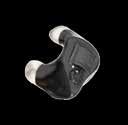




Continued from page 8





is my first time I competed offshore.”
McNair said she and her team fished in honor of Sonia Schilling, an old friend and angler.
“We went more than 60 miles to get our fish,” she said.
McNair also caught a shark that took her about a half-hour to the boat.
Anglers said fishing in the bay started off fair but tailed off around 11 a.m., with fishermen left hoping for a breeze to pick up.
Jeanette Greider, South Pardre Island Chamber of Commerce president and tournament director, said LKT is one of the largest all-women tournaments along the Texas Gulf Coast.
Division winners:
Blackfin tuna
Bonita
Dorado
Flounder
Kingfish
Redfish
Speckled trout



After announcing stringent rules on bringing dogs back into the United States in June, especially involving returning from Canada, the Centers for Disease Control and Prevention received significant pushback from conservation groups, including Ducks Unlimited, and members of Congress.
Rep. Nick Langworthy, (R-NY) penned a bipartisan letter urging the CDC to simplify or delay its proposed rules, a letter supported by hunting and conservation groups.
The CDC then announced revised canine travel and importation guidelines that go into effect Aug. 1, easing the minds of waterfowlers soon to head north who were worried about the rules causing an issue when they return home with their dog.
Although the new guidelines are more straightforward, hunters still need to make sure they have everything properly in order before heading north this fall, including the usual requirements from the Canadian Food Inspection Agency.
The updated CDC-specific requirements are as follows:
• Dog Import Form: If your dog has only been in countries that are rabies-free or low-risk in the past 6 months (Canada is considered rabiesfree), the only new document you now need is verification of completion of a CDC Dog Import Form online. Once the form is complete, hunters must save a receipt digitally or print it out physically.
• Good Health: Your dog must appear healthy to enter or re-enter the U.S.

• Microchip: Dogs must have a valid microchip that can be detected with a universal scanner to identify them.
• Age Requirement: Dogs must be at least 6 months old.
Additional CFIA Requirements
When traveling across the border to Canada with your dog, the CFIA has a brief set of their own unique requirements familiar to U.S. hunters. Upon crossing, you’ll need to ensure your retriever has the following:
• A valid rabies vaccination certificate
• Appears healthy
Continued from page 4
“She was in some of the thickest nastiest brush up against a bluff, a typical place lions like to bay,” Brown said.
Then the dogs got quiet and began sniffing around. The two men walked the creek and scoured the trees above them. After 30 minutes with no luck and rising temperatures, they were feeling disheartened.
“I had given up,” Brown said. “I told Randy you know it’s all about just getting the dogs out and watching them work.”
Later, around 1 p.m., one dog sounded off, then another, then they all belted their treed bark at the top of their lungs. Brown crept over the side of the creek and laid his eyes on a treed lion. He quietly motioned for Methvin.
“I guess he didn’t realize I had seen it because he sure took his time coming up to me,” Brown chuckled. “Well, are you ready to shoot?”
Due to the angle, he had to shoot through some thin limbs. Methvin raised his father’s .30-30, took the shot and dropped the tom. The dogs’ hard work had been rewarded by a hefty male.
“It’s much bigger in person,” Methvin said.
The friends quickly got the lion field dressed and headed to Uvalde to get it to a cooler. Methvin made some calls, and they were met by biologists David Rios and Javier Huerta. The biologists took a molar to age the cat, weighed the tom (127 pounds) and took measurements. The results of the molar test have yet to come in, but Brown estimated the lion to be around 6 years old.
The hunt meant the world to the two old friends. Brown finally put a stop to a fellow hunter that had outsmarted him in the past, and Methvin got to harvest a bucket-list animal with his fathers “60.”
Hunting dogs have been a part of Brown’s life as long as he can remember, just like his father. He started off with raccoons, foxes, bobcats and lions. Around 1995, he weened his dogs off all game except for lions and bobcats. Brown mainly hunts lions in West Texas.



AUGUST 21
BIG COUNTRY OUTPOST
Grand Opening
Albany bigcountryoutposttx.com
AUGUST 24
QUAIL COALITION
South Texas Dinner & Auction
Richard M. Borchard Fairgrounds Robstown quailcoalition.org
DUCKS UNLIMITED
Celina Dinner
3R’s Ranch, Prosper (972) 822-8549 ducks.org
NATIONAL WILD TURKEY FEDERATION
East Texas Chapter Banquet The Cain Center, Athens (918) 637-8860 nwtf.org
SEPTEMBER 1
FORT WORTH SCI CHAPTER
Annual Member Dove Hunt
Nine Bar Ranch, Decatur jeffkennedy@fortworthsafariclub.org
SEPTEMBER 6
OPERATION GAME THIEF
Clay Stoppers Shootout
National Shooting Complex San Antonio ogttx.org

DUCKS UNLIMITED
SEPTEMBER 7
MULE DEER FOUNDATION
Alpine Banquet
Alpine Civic Center (432) 290-4563 muledeer.org
SEPTEMBER 12
WHITETAILS UNLIMITED
Southeast Texas Deer Camp Compro Event Center, Beaumont (409) 201-7097 whitetailsunlimited.com
SEPTEMBER 13
CAESAR KLEBERG WILDLIFE RESEARCH INSTITUTE
South Texas Wildlife Conference Pleasanton Civic Center texas-wildlife.org
SEPTEMBER 13-14
LEGENDS DOVE HUNT Abilene (325) 670-6557 legendsdovehunt.com
SEPTEMBER 14-15
TEXAS GUN & KNIFE SHOWS Kerrville Expo Hall (830) 285-0575 texasgunandknifeshows.com
SEPTEMBER 19
DALLAS SAFARI CLUB
Member Stories from the Field Ozona Bar and Grill (972) 980-9800 biggame.org


Ricebelt Dinner El Campo Civic Center (979) 578-1470 ducks.org
DUCKS UNLIMITED Paris Banquet, Elks Lodge (903) 782-2172 ducks.org
SEPTEMBER 21
MULE DEER FOUNDATION
Odessa/Permian Basin Banquet Odessa Country Club (432) 290-4563 muledeer.org

MERCY CLINIC OF FORT WORTH Shoot for Life Fundraiser Sporting Clays Tournament Defender Outdoors, Fort Worth (817) 840-3501 mercyclinicfriends.org
DALLAS SAFARI CLUB Hunter Ed Course DSC Headquarters (972) 980-9800 biggame.org
SEPTEMBER 26
HOUSTON LEGACY GALA Lakeside Country Club (713) 471-8854 ducks.org



Puzzle solution from Page 18




DSC’s mission is to ensure the conservation of wildlife through public engagement, education and advocacy for well-regulated hunting and sustainable use.
The vision of DSC is a society that values wildlife, engages in its conservation and understands and supports the role of well-regulated hunting in the sustainable use of wild resources.
